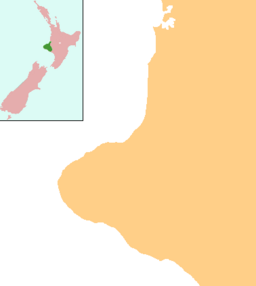Lake Rotokare facts for kids
Quick facts for kids Lake Rotokare |
|
|---|---|
 |
|
| Location | Taranaki, North Island |
| Coordinates | 39°27′S 174°25′E / 39.45°S 174.41°E |
| Primary inflows | springs |
| Primary outflows | Te Ararata Stream |
| Basin countries | New Zealand |
| Surface area | 17.8 ha (44 acres) |
| Average depth | 6 m (20 ft) |
Lake Rotokare is a special lake in the New Zealand region of Taranaki. It was formed naturally when a landslide blocked a valley, creating a dam. This lake is located about 12 kilometers (7.5 miles) east of the town of Eltham.
The area around Lake Rotokare is a very important nature reserve. It covers about 230 hectares (568 acres). This reserve is New Zealand's largest wetland and lake habitat that is protected by a special predator-proof fence. This fence helps keep out harmful animals like stoats and rats. The reserve is managed by the South Taranaki District Council and the Rotokare Scenic Reserve Trust.
It's important not to confuse Lake Rotokare with Barrett Lagoon. Barrett Lagoon is near New Plymouth and also has the Māori name Rotokare.
Contents
History of the Reserve
The Rotokare Scenic Reserve was first created in the early 1870s. This means it has been a protected area for a very long time! A road was built to access the reserve in 1914, making it easier for people to visit.
Building the Predator-Proof Fence
A big step for the reserve happened in 2008. The Rotokare Scenic Reserve Trust finished building a special fence all around the reserve. This fence is designed to keep out predators. Predators are animals that hunt and eat other animals. In New Zealand, introduced predators like stoats, rats, and possums have caused a lot of harm to native wildlife. The fence helps protect the rare and special plants and animals inside.
Amazing Plants and Animals
The Rotokare Scenic Reserve is home to many different kinds of native plants and animals. It's a safe place for them to live and grow.
Plants of Rotokare
You can find many native plants here. Some common ones include raupo (a type of wetland plant), flax (a plant with long, tough leaves), purei, and makura. There are also trees like pukatea, kahikatea, coprosma, and swamp maire. Other plants like water millet and jointed baumea grow in the wetland areas.
Wildlife of Rotokare
The reserve is a haven for many native animals.
Birds
Many native birds live at Lake Rotokare. You might spot an Australasian bittern, which is a shy wetland bird. There are also spotless crake and fernbird. These birds are often hard to see because they hide in the thick plants.
Reptiles
The reserve is home to the gold-striped gecko. Geckos are small lizards that are active at night.
Fish and Other Water Creatures
In the lake and streams, you can find different fish. These include the banded kokopu, a native freshwater fish. There are also koura, which are New Zealand's native freshwater crayfish. And of course, there are short-finned and long-finned eels, which are important parts of the freshwater ecosystem.
Reintroduction of Native Birds
One of the most exciting things happening at Rotokare is bringing back native bird species that used to live there. This helps to increase their numbers and make the ecosystem healthier.
Stitchbird Reintroduction
In 2017, Hihi (also known as stitchbirds) were brought to the reserve. More birds were added to this population in 2018. Hihi are small, colorful birds that are very rare.
Brown Teal Reintroduction
In May 2019, Pateke (brown teal) were introduced into the reserve. Pateke are a type of native duck. They are also an endangered species, so finding safe places for them to live is very important.


